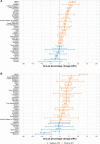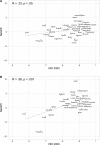Global epidemiologic patterns of oropharyngeal cancer incidence trends
- PMID: 37603716
- PMCID: PMC10699798
- DOI: 10.1093/jnci/djad169
Global epidemiologic patterns of oropharyngeal cancer incidence trends
Abstract
Background: The emergence of human papillomavirus (HPV)-positive oropharyngeal cancer and evolving tobacco use patterns have changed the landscape of head and neck cancer epidemiology internationally. We investigated updated trends in oropharyngeal cancer incidence worldwide.
Methods: We analyzed cancer incidence data between 1993 and 2012 from 42 countries using the Cancer Incidence in Five Continents database volumes V through XI. Trends in oropharyngeal cancer incidence were compared with oral cavity cancers and lung squamous cell carcinomas using log-linear regression and age period-cohort modeling.
Results: In total, 156 567 oropharyngeal cancer, 146 693 oral cavity cancer, and 621 947 lung squamous cell carcinoma patients were included. Oropharyngeal cancer incidence increased (P < .05) in 19 and 23 countries in men and women, respectively. In countries with increasing male oropharyngeal cancer incidence, all but 1 had statistically significant decreases in lung squamous cell carcinoma incidence, and all but 2 had decreasing or nonsignificant net drifts for oral cavity cancer. Increased oropharyngeal cancer incidence was observed both in middle-aged (40-59 years) and older (≥60 years) male cohorts, with strong nonlinear birth cohort effects. In 20 countries where oropharyngeal cancer incidence increased for women and age period-cohort analysis was possible, 13 had negative or nonsignificant lung squamous cell carcinoma net drifts, including 4 countries with higher oropharyngeal cancer net drifts vs both lung squamous cell carcinoma and oral cavity cancer (P < .05 for all comparisons).
Conclusions: Increasing oropharyngeal cancer incidence is seen among an expanding array of countries worldwide. In men, increased oropharyngeal cancer is extending to older age groups, likely driven by human papillomavirus-related birth cohort effects. In women, more diverse patterns were observed, suggesting a complex interplay of risks factors varying by country, including several countries where female oropharyngeal cancer increases may be driven by HPV.
© The Author(s) 2023. Published by Oxford University Press. All rights reserved. For permissions, please email: journals.permissions@oup.com.
Conflict of interest statement
Dr Chaturvedi is supported by the Intramural Research Program of the National Cancer Institute. Dr Zumsteg’s spouse previously performed legal work for Johnson & Johnson, Allergan, Merck, and Boehringer Ingelheim. The other authors have nothing else to disclose.
Figures






Comment in
-
The evolving landscape of oropharyngeal cancer: a window of opportunity for primary prevention.J Natl Cancer Inst. 2023 Dec 6;115(12):1454-1456. doi: 10.1093/jnci/djad171. J Natl Cancer Inst. 2023. PMID: 37794753 No abstract available.
References
-
- Lorenzoni V, Chaturvedi AK, Vignat J, et al.The Current Burden of Oropharyngeal Cancer: a global assessment based on GLOBOCAN 2020. Cancer Epidemiol Biomarkers Prev. 2022;31(11):2054-2062. - PubMed
-
- Hashibe M, Brennan P, Benhamou S, et al.Alcohol drinking in never users of tobacco, cigarette smoking in never drinkers, and the risk of head and neck cancer: pooled analysis in the International Head and Neck Cancer Epidemiology Consortium. J Natl Cancer Inst. 2007;99(10):777-789. - PubMed
Publication types
MeSH terms
Grants and funding
LinkOut - more resources
Full Text Sources
Medical

